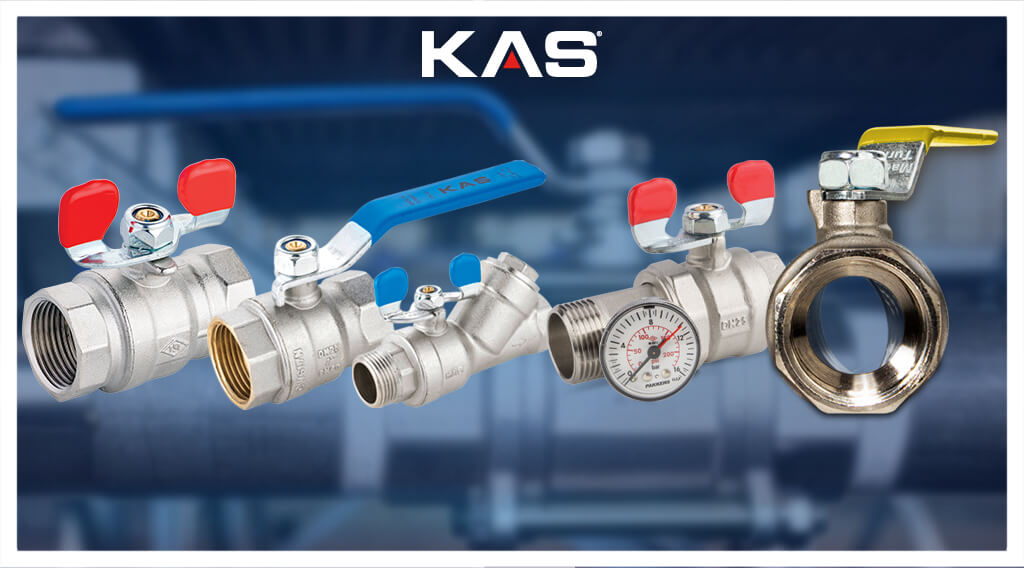Differences Between Valve Types and Their Applications
One of the most critical components of piping systems is valves, which are mechanisms used to control, direct, or completely stop the flow of liquids or gases. Choosing the right valve is vital for the safety, efficiency, and longevity of the system. An incorrectly selected or improperly installed valve can cause numerous problems, ranging from water leakage and pressure loss to serious system failures.
Valves differ according to their intended use, internal mechanisms, and the materials from which they are manufactured. In this article, we will examine valve types, their applications, and key tips for making the right choice; and then introduce KAS brand’s high-quality valve solutions.

1. Ball Valve
Definition: Ball valves are mechanisms containing a perforated ball inside, which controls the flow depending on the ball’s position.
Advantages:
Quick on/off with a single movement
High sealing performance
Long service life
Applications:Domestic hot and cold water systems
Natural gas and similar gas systems
Industrial fluid lines
Underfloor heating systems
2. Gate Valve
Definition: This valve type controls the flow by moving a gate up and down.
Advantages:
Minimal pressure loss when fully open
Effective for large-diameter pipelines
Applications:Main water supply lines
Industrial process lines
High-flow systems
3. Butterfly Valve
Definition: Valves in which a disk-shaped plate rotates to control the flow.
Advantages:
Lightweight structure
Fast open/close operation
Suitable for medium-pressure systems
Applications:Ventilation lines
Large-diameter water pipelines
Agricultural irrigation systems
4. Strainer
Definition: Components that filter foreign particles within the fluid, protecting the system.
Advantages:
Extends the service life of equipment and pipelines
Reduces clogging risk
Applications:Heating and cooling systems
Pump inlets
Industrial pipelines
5. Check Valve
Definition: Valves that allow flow in only one direction and prevent backflow.
Advantages:
Ensures system safety by preventing reverse flow
Protects pumps and equipment
Applications:Pump outlets
Water tanks
High-rise buildings
6. Thermostatic Radiator Valve (TRV)
Definition: Valves that automatically adjust water flow according to room temperature.
Advantages:
Energy savings
Comfortable temperature control
Applications:Residences, offices, schools, hospitals, places of worship, and all areas where automatic temperature regulation is needed
Key Points When Choosing a Valve
Pressure and temperature ratings: Must be suitable for the system’s operating conditions.
Material: Brass, stainless steel, cast iron, etc., should be selected based on system requirements.
Connection type: Threaded, flanged, or welded connections should be chosen as needed.
Sealing performance: High sealing is essential, especially in water and gas systems.
Ease of maintenance: Availability of service and spare parts is important for long-term operation.
KAS Valve Solutions: A Reliable Choice for Quality and Durability
With years of experience in valve production, high-quality raw materials, and modern manufacturing technology, KAS stands out as a trusted brand. Its product range offers various valve solutions for residential, commercial, and industrial applications.
KAS’s Featured Valve Products:
Ball Valves: Brass body, chrome plating, high sealing performance; suitable for both domestic and industrial use.
Strainers: Provide particle filtration in heating, cooling, and pump systems, extending equipment life.
Check Valves: One-way flow control that enhances pump and system safety.
Thermostatic Valves: Smart solutions that automatically adjust temperature to improve energy efficiency.
KAS valves are highly preferred by installation professionals thanks to their high-pressure resistant bodies, long-lasting sealing elements, and superior corrosion protection. They guarantee trouble-free performance both in drinking water installations and in heating/cooling systems.
Valve selection is a critical step for the safety and efficiency of piping systems. Determining the right valve type for each application not only reduces the risk of malfunctions but also lowers maintenance costs. KAS’s durable and reliable valve solutions, when properly installed and regularly maintained, provide long-lasting, trouble-free service. In both residential and industrial projects, you can experience the difference of KAS quality.

 English
English